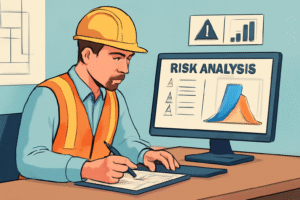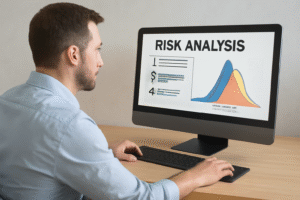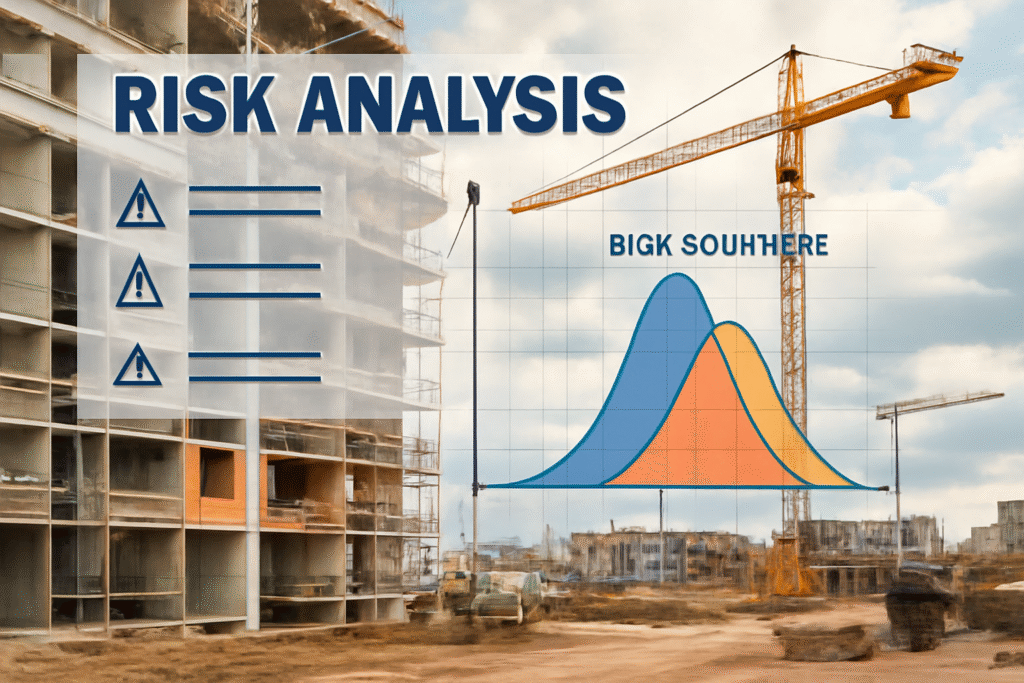Learn how to integrate risk analysis in estimating process with 5 key strategies that improve the accuracy of your predictions and ensure project success. Risk Analysis in Estimating:
Introduction
In the world of construction and project management, estimating project costs and timelines is more than just a matter of calculating the total costs. Estimators must also account for the uncertainties that can arise during a project. This is where risk analysis comes into play. Risk analysis in estimating is an essential component that helps professionals predict potential pitfalls, budget overruns, and delays, allowing them to take proactive steps to mitigate these risks before they impact the project’s outcome.
In this blog post, we’ll explore five key strategies for effectively incorporating risk analysis in estimating process. These strategies not only enhance the accuracy of your estimates but also provide you with a clear roadmap for managing the unpredictable nature of construction projects.

1. Understand the Types of Risk in Estimating
The first step in integrating risk analysis into estimating is understanding the different types of risk that can affect a project. These risks can be categorized into several types:
-
Technical Risks: These include risks related to design errors, technical challenges, and failures in materials or workmanship.
-
Operational Risks: These risks are linked to the daily operations of a project, including labor shortages, equipment failure, and logistical issues.
-
Market Risks: These involve the external economic factors such as changes in material prices, labor costs, and interest rates that can affect the overall cost of the project.
-
Legal and Regulatory Risks: These risks include changes in laws, regulations, or permits that may affect the project timeline or costs.
-
Environmental Risks: Unexpected weather conditions, natural disasters, or unforeseen environmental factors can create disruptions during the project.
By understanding these risks, estimators can assess their potential impact and prioritize them based on their likelihood and severity.
2. Incorporate Monte Carlo Simulation for Risk Quantification
One of the most powerful tools for risk analysis in estimating is Monte Carlo simulation. This statistical technique helps to predict the likelihood of various outcomes in a project by running simulations based on a range of possible values for key variables (such as labor cost, material price, or project timeline).
Monte Carlo simulation uses a random sampling method to generate multiple scenarios and produce a distribution of possible outcomes. By inputting values such as the best-case, worst-case, and most likely cost estimates for the project, you can simulate thousands of scenarios, providing a range of possible results. This allows estimators to better understand the risks associated with the project and make more informed decisions.
The benefits of incorporating Monte Carlo simulation include:
-
Greater accuracy in cost and timeline predictions.
-
A clear visual representation of the potential risks and uncertainties.
-
A better understanding of the probabilities of achieving certain outcomes.
Using Monte Carlo simulation, you can assess the financial and operational risks more effectively, leading to more accurate estimates and risk mitigation strategies.
3. Sensitivity Analysis: Identifying Key Variables
Another important strategy for risk analysis in estimating is sensitivity analysis. This technique helps to identify which variables have the greatest impact on the project’s overall cost or timeline. By analyzing the effect of changes in individual inputs (such as material cost, labor rates, or project scope), estimators can determine which factors are the most sensitive to change.
The sensitivity analysis can be conducted by changing one variable at a time while keeping others constant and observing how the project’s cost or schedule is affected. This helps to:
-
Prioritize the most important risk factors.
-
Identify areas where more accurate data or contingency planning is needed.
-
Evaluate how small changes in certain variables can lead to significant impacts on project outcomes.
By identifying the key variables, you can focus your risk mitigation efforts where they will have the most significant impact, ensuring that your estimate remains accurate and robust.
4. Establish Contingency Plans
No matter how thorough your risk analysis process is, it’s inevitable that some risks will materialize. That’s why contingency planning is an essential aspect of the estimating process. A contingency plan is a predefined response to specific risks that can help minimize their impact on the project.
Contingency plans should include:
-
Contingency Budget: Allocate a portion of the project budget to cover unexpected costs arising from risk events.
-
Time Buffers: Include extra time in the project schedule to accommodate delays caused by unforeseen risks.
-
Action Plans: Develop specific actions that will be taken if certain risks materialize, such as switching suppliers, hiring additional staff, or adjusting the project scope.
Having these contingency plans in place allows project managers and estimators to respond quickly to unexpected changes, helping to keep the project on track and within budget.

5. Regular Risk Monitoring and Reassessment
Risk analysis is not a one-time task. As a project progresses, new risks can emerge, and existing risks can evolve. Therefore, regular risk monitoring and reassessment are crucial for ensuring that the estimates remain accurate throughout the project’s lifecycle.
Monitoring involves tracking the identified risks to see if they are materializing, while reassessment involves updating the risk analysis based on new information or changes in the project scope. By continually assessing the risks, you can:
-
Update cost and timeline estimates to reflect new realities.
-
Identify any emerging risks that were not previously anticipated.
-
Adjust contingency plans as needed to address changes in the risk landscape.
Establishing a process for regular risk reassessment helps to ensure that you remain proactive in managing the uncertainties inherent in construction projects.
Conclusion
Risk analysis in estimating is an essential skill that can significantly improve the accuracy and reliability of your project predictions. By understanding the types of risks, incorporating advanced techniques like Monte Carlo simulation and sensitivity analysis, and establishing effective contingency plans, you can better navigate the uncertainties of construction projects.
However, it’s important to remember that risk analysis is an ongoing process. Regularly monitoring and reassessing the risks throughout the project will help you stay ahead of potential issues and adjust your estimates as needed. By mastering risk analysis, you can not only provide more accurate estimates but also ensure that your projects are completed successfully, on time, and within budget.
Contact Information for Zion Estimating:
- Phone Number: 718-427-9941
- Email Address: [email protected]
- Website: https://zionestimating.com
